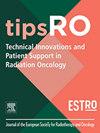如何应对放疗过程中的直肠运动?
Q1 Nursing
Technical Innovations and Patient Support in Radiation Oncology
Pub Date : 2024-09-25
DOI:10.1016/j.tipsro.2024.100277
引用次数: 0
摘要
导言直肠在分次内和分次间的运动对盆腔放疗(RT)非常重要。本研究评估了 RT 疗程持续时间、直肠内肿瘤存在与否以及与肛门直肠交界处(ARJd)的距离对直肠运动的影响。评估了三种结构:(1) 无直肠肿瘤患者的整个直肠(RectumProstate);(2) 直肠癌患者的未侵袭部分(RectumRectum)和(3) 肿瘤侵袭部分(RectumTumour)。线性混合模型分别评估了直肠运动与时间、肿瘤存在和 ARJd 的关系。结果我们纳入了 10 名直肠癌患者和 10 名非直肠癌患者,收集了 385 张 CBCT。结果发现,直肠运动与 RT 治疗持续时间之间存在明显相关性(p < 0.05)。前列腺癌患者的牵引内运动明显较高(RectumProstate motion > RectumRectum and RectumTumour, p <0.01)。就牵引间运动而言,只有 RectumProstate 的平均一致距离明显更高(p < 0.05)。结论会话持续时间、无肿瘤和 ARJd 与较大的直肠牵引内和牵引间运动有关。这凸显了定制化 RT 治疗的必要性,包括在线自适应 RT,以管理牵引内和牵引间的变化。前列腺癌患者和直肠癌患者的直肠运动应区别对待。本文章由计算机程序翻译,如有差异,请以英文原文为准。
Dealing with rectum motion during radiotherapy: How can we anticipate it?
Introduction
Intra- and inter-fraction rectum motion is important for pelvic radiotherapy (RT). This study assesses how RT session duration, the presence or the absence of an intra-rectal tumour, and the distance from the anorectal junction (ARJd) impact rectal motion.
Materials and methods
Analyses used cone-beam computed tomographies (CBCTs) from RT patients treated for rectal and prostate cancer. Three structures were evaluated: (1) the entire rectum in patients without a rectal tumour (RectumProstate); (2) the non-invaded portion (RectumRectum) and (3) the tumour-invaded portion (RectumTumour) in rectal cancer patients.
Intrafraction motion was assessed using the Hausdorff distance 95% and the Mean distance-to-agreement between structures delineated on the first CBCT and the 2 subsequent CBCTs within a same RT session. Interfraction motion was quantified by comparing structures delineated on the planning-CT and the first CBCT of each session.
Linear mixed model evaluated rectum motion in relation to time, tumour presence, and ARJd, respectively.
Results
We included 10 patients with and 10 without rectal cancer, collecting 385 CBCTs. A significant correlation (p < 0.05) between rectum motion and RT session duration was found. Intrafraction motion was significantly higher in prostate cancer patients (RectumProstate motion > RectumRectum and RectumTumour, p < 0.01). For interfraction motion, only the mean distance to agreement was significantly higher for RectumProstate (p < 0.05). Motion increased significantly with ARJd for all three structures (p < 0.001).
Conclusions
Session duration, absence of a tumour, and ARJd are associated with larger intra- and interfraction rectal motion. This highlights the need for tailored RT treatment, including online-adaptive RT, to manage intra- and interfraction variations. Rectal motion should be handled differently for patients with prostate cancer and those with rectal cancer.
求助全文
通过发布文献求助,成功后即可免费获取论文全文。
去求助
来源期刊

Technical Innovations and Patient Support in Radiation Oncology
Nursing-Oncology (nursing)
CiteScore
4.10
自引率
0.00%
发文量
48
审稿时长
67 days
 求助内容:
求助内容: 应助结果提醒方式:
应助结果提醒方式:


